
The £40 Energy Bill: How a Garden Shed Data Center Reveals the Future of Fintech and Sustainable Investing
In a quiet corner of Norfolk, England, Terrence Bridges is running a sophisticated data center. It’s not in a sprawling, climate-controlled warehouse, but in his garden shed. The most remarkable part? His innovation has slashed his household energy bills to a mere £40 per month. “It’s fantastic because it’s eco-friendly…We’re not burning any gases,” he told the BBC. While this might seem like a quirky, homespun project, it serves as a powerful microcosm of a monumental shift impacting the global economy, from high-frequency trading floors to the core infrastructure of the banking industry.
This isn’t just a story about saving on heating. It’s a profound lesson in resource allocation, energy arbitrage, and the hidden economics of our digital world. For investors, finance professionals, and business leaders, Bridges’s shed is a window into the future—a future where the physical byproducts of digital processes are no longer waste, but valuable assets. This is the story of how turning a liability (excess heat) into an asset (home heating) provides a blueprint for the next wave of innovation in financial technology and sustainable investing.
The Invisible Engine: Data Centers and Their Colossal Economic Footprint
Before we can appreciate the genius of the shed, we must understand the beast it tames. Data centers are the invisible, humming engines of modern civilization. Every time you use a mobile banking app, execute a trade on the stock market, or leverage a fintech platform for a loan, you are accessing a data center. They are the physical backbone of the digital economy.
This immense power comes at an equally immense cost: energy. Data centers are notoriously power-hungry. Globally, they are estimated to consume between 1-2% of all electricity produced, a figure that is constantly rising with the advent of AI and more complex computational tasks. According to the International Energy Agency, global data center electricity consumption was 240-340 TWh in 2022, roughly equivalent to the entire annual electricity demand of Australia (source). A significant portion of this energy, often over 40%, is used not for computation itself, but for cooling the servers to prevent them from overheating.
In the world of finance, this energy expenditure is mission-critical. High-frequency trading (HFT) firms co-locate their servers as close as possible to stock exchange data centers to shave microseconds off transaction times. The rise of decentralized finance (DeFi) and blockchain technologies requires vast, distributed computational power. Every digital transaction, every risk analysis model, and every secure customer portal is powered by these energy-intensive facilities. The heat they generate is a massive, costly, and environmentally damaging negative externality—a problem that, until now, most have simply paid to solve with more energy.
Grounded Flights, Grounded Economy: The Hidden Financial Turbulence of a Government Shutdown
The ‘Shed Model’: A Paradigm Shift in Asset Utilization and Economics
Terrence Bridges’s solution flips the traditional model on its head. Instead of paying to dissipate the heat from his servers, he harnesses it. The hot air is captured and used to heat his home and water, effectively turning a waste product into a valuable utility. This is a masterclass in first-principles economics: identifying and monetizing an inefficiency in a system.
Let’s visualize the financial impact of this approach. While exact figures vary, we can construct a simplified comparison to illustrate the economic advantage.
| Expense Category | Typical 3-Bedroom UK Home (Estimate) | ‘The Shed Model’ (Bridges’s Case) | Economic Implication |
|---|---|---|---|
| Electricity (General) | £100 – £150 | £40 (Total Bill) | Drastic reduction in operational expenditure. |
| Gas (Heating & Hot Water) | £100 – £140 | £0 | Elimination of a major utility cost by replacing it with a ‘free’ byproduct. |
| Data Center Cooling Cost | N/A (Not applicable for homes) | -£100 to -£140 (Value of heat captured) | Transforms an operational cost (cooling) into a direct financial benefit (heating). |
| Total Estimated Utility Bill | £200 – £290 | £40 | Over 80% reduction in monthly household energy costs. |
This model introduces a powerful concept for businesses: industrial symbiosis. What if data centers were no longer isolated facilities but were integrated into communities and other industries? Imagine a data center providing the heat for a municipal swimming pool, a greenhouse complex, or a district heating system for an entire neighborhood. The business running the data center could create a new revenue stream by selling heat, while the buyer gets a cheaper, more sustainable energy source. This is the scalable, industrial version of what Bridges has achieved in his shed.
Decentralization: From a Single Shed to the Future of Financial Technology
The “shed data center” is also a tangible example of a powerful trend reshaping technology: decentralization and edge computing. Edge computing is a model where data is processed closer to where it is generated, rather than being sent to a centralized cloud. This reduces latency, improves speed, and can enhance security.
Consider the implications for the financial technology sector:
- High-Frequency Trading: Edge data centers can be placed in unconventional locations to be physically closer to exchanges or key network nodes, offering a competitive advantage in a game won by microseconds.
- Secure Banking: For regional banking, processing sensitive customer data locally at a branch level before it ever touches the cloud can add a powerful layer of security and comply with data residency regulations.
- Blockchain & Crypto: One of the biggest criticisms of blockchain technologies like Bitcoin is their immense energy consumption. A distributed network of small, energy-efficient nodes that reuse their waste heat could fundamentally change the profitability and sustainability equation for crypto mining and decentralized applications. A 2022 White House report highlighted that U.S. crypto-asset activity was responsible for electricity usage comparable to that of all home computers in the country (source). Innovative solutions are desperately needed.
This decentralized approach transforms the data center from a monolithic entity into a flexible, distributed network. Mr. Bridges’s setup, while small, is a node in such a potential network. For fintech startups, this could lower the barrier to entry, reducing reliance on expensive contracts with major cloud providers and offering new ways to build resilient and efficient infrastructure.
The Great Unbundling: Why Private Equity is Carving Up Europe’s Industrial Empires
The New ESG: Investing in Efficiency and Symbiosis
For the astute investor, this story resonates deeply with the principles of Environmental, Social, and Governance (ESG) investing. For years, ESG has often been about avoiding “bad” companies (like fossil fuel producers) or investing in “good” ones (like renewable energy). However, the next evolution of ESG is about finding companies that are fundamentally more efficient and less wasteful in their core operations.
The “shed model” highlights a new class of investment opportunities:
- Heat-Reuse Technology: Companies developing and patenting the hardware and software to efficiently capture, transfer, and utilize waste heat from servers.
- Sustainable Infrastructure REITs: Real Estate Investment Trusts that specialize in developing and managing properties that co-locate data centers with heat-dependent industries.
- Decentralized Computing Platforms: Startups creating platforms that allow individuals and small businesses to rent out their computing power in a distributed network, with energy reuse built into the model.
As regulatory pressure and consumer demand push for greater sustainability, companies that can turn an environmental liability into a financial asset will have a significant competitive advantage. Their operational costs will be lower, their business models more resilient, and their appeal to ESG-focused capital will be far greater. This isn’t just about being green; it’s about superior economics that will ultimately be reflected in the stock market.
Beyond the Tinsel: What Christmas Ads Reveal About the Global Economy and Investment Landscape
Challenges on the Path to a Decentralized Future
Of course, scaling this model from a single shed to a global standard is fraught with challenges. A pragmatic and professional outlook requires acknowledging these hurdles.
- Security: A decentralized network of data centers is inherently more difficult to secure than a centralized one. Physical security, data encryption, and network integrity become paramount concerns.
- Maintenance & Reliability: Enterprise clients demand near-perfect uptime. Managing maintenance and ensuring reliability across thousands of small, distributed nodes is an immense logistical challenge compared to managing a single, large facility.
- Geographic & Climatic Limitations: Heat reuse is most valuable in colder climates. The economic model is less compelling in tropical regions where the primary need is for cooling, not heating.
- Regulatory Landscape: Data sovereignty laws, energy regulations, and zoning ordinances would all need to be navigated for a truly widespread deployment of integrated data centers.
Conclusion: From a Simple Premise, a Profound Opportunity
Terrence Bridges’s garden shed data center is more than a charming anecdote. It is a powerful proof of concept for the future of digital infrastructure. It demonstrates that the byproducts of the digital world can be reintegrated into the physical world to create immense value, reduce waste, and build more resilient systems. For professionals in finance, technology, and investing, the message is clear: the biggest opportunities for growth often lie in challenging fundamental assumptions about what constitutes a cost versus what constitutes an asset.
The core tenets of this model—efficiency, symbiosis, and decentralization—are the very principles that will define the next generation of successful businesses in the digital economy. The simple act of heating a home with a computer has laid bare a multi-trillion-dollar opportunity to re-engineer the physical footprint of our digital lives, creating a more sustainable and economically efficient world for everyone.


